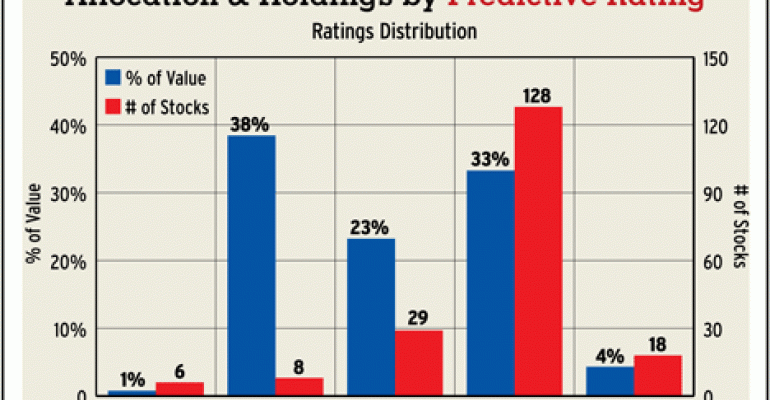Two of the three stocks added to our large/mid cap Most Dangerous stocks list for November are from the energy sector. Those stocks are Energy XXI (Bermuda) Ltd. (EXXI) and Superior Energy Services (SPN) – both get my very dangerous rating as do all of the Most Dangerous stocks. Notably, Dynergy (DYN) also had my very dangerous rating when it announced bankruptcy might be in its future in late June of this year.
There are no energy stocks on our Most Attractive stocks list for November but there are 14 attractive-or-better-rated stocks in the energy sector, such as Exxon Mobil (XOM), Chevron (CVX) and Diamond Offshore Drilling (DO). Figure 1 shows that nearly 40% of the market cap of this sector gets an attractive-or-better rating.
So you would think that there are lots of attractive ETFs in the energy sector, right? Wrong.
There are no attractive-or-better rated ETFs despite nearly 40% of the market cap of the sector getting our attractive-or-better rating. In fact, none of the energy sector ETFs are better than the S&P 500, which provides a decent amount of exposure to energy along with additional diversification.

Figure 2 shows how 15 Energy sector ETFs stack up versus each other, the overall sector and the S&P 500 based on their predictive ratings and the allocation of their holdings by rating.
All of the energy sector ETFs get a dangerous rating, which means you should sell them.

Another important takeaway from the figure above is that investors cannot trust the labels on energy ETFs.
Just because the ETF issuers call it an “energy ETF”, investors cannot trust they are getting exposure to the best that the energy sector has to offer. I see the same issue in ETFs across all sectors.
My next observation is that ETF issuers are doing their best to sell as many ETFs as possible and give investors as many choices as possible. Figure 3 lists 15 U.S. equity energy sector ETFs that we cover.

There are major differences in methodologies between ETFs, which results in drastically different holdings even within a given sector. And the problem is that the passively-managed ETFs are not doing a good job of allocating to the good stocks in the sector. Do not be blinded by the smoke.
My recommendation is that investors build their own portfolio of energy stocks rather than trust someone else to do it for them. Otherwise, I think you might get burned.
Disclosure: David Trainer receives no compensation to write about any specific stock, sector or theme.
About the Author
David Trainer is an investment strategist and corporate finance expert. He is CEO of New Constructs, a research firm. He specializes in analyzing stocks and markets based on the true economics of business performance rather than misleading accounting data. He is author of the chapter “Modern Tools for Valuation” in The Valuation Handbook (Wiley Finance 2010).






